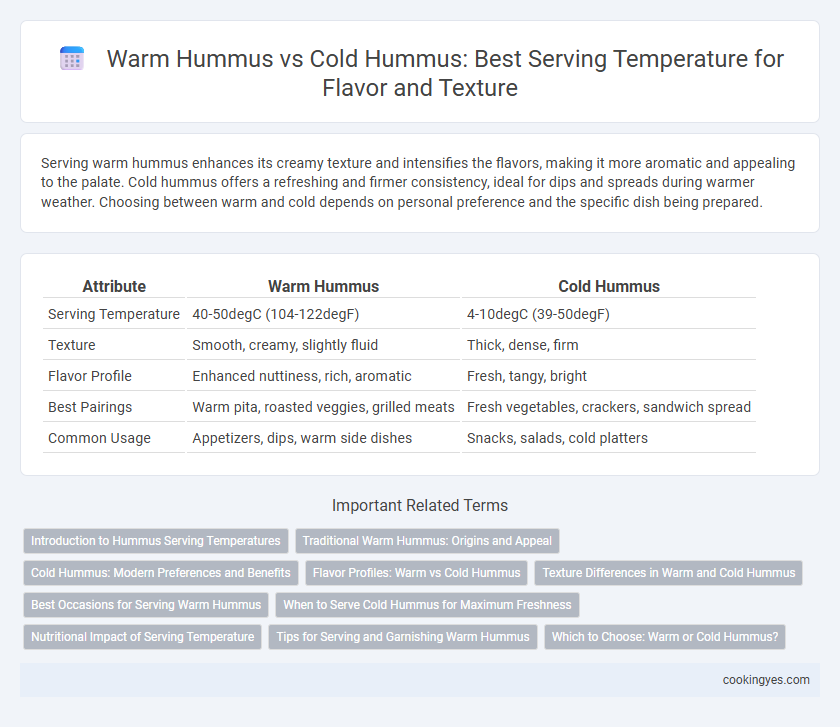Serving warm hummus enhances its creamy texture and intensifies the flavors, making it more aromatic and appealing to the palate. Cold hummus offers a refreshing and firmer consistency, ideal for dips and spreads during warmer weather. Choosing between warm and cold depends on personal preference and the specific dish being prepared.
Table of Comparison
| Attribute | Warm Hummus | Cold Hummus |
|---|---|---|
| Serving Temperature | 40-50degC (104-122degF) | 4-10degC (39-50degF) |
| Texture | Smooth, creamy, slightly fluid | Thick, dense, firm |
| Flavor Profile | Enhanced nuttiness, rich, aromatic | Fresh, tangy, bright |
| Best Pairings | Warm pita, roasted veggies, grilled meats | Fresh vegetables, crackers, sandwich spread |
| Common Usage | Appetizers, dips, warm side dishes | Snacks, salads, cold platters |
Introduction to Hummus Serving Temperatures
Hummus is traditionally served at a variety of temperatures, enhancing its versatility as a dip or spread. Warm hummus often has a creamier texture and richer flavor, making it ideal for savory dishes or appetizers. Cold hummus retains its firm structure, providing a refreshing contrast when paired with fresh vegetables or crackers.
Traditional Warm Hummus: Origins and Appeal
Traditional warm hummus originates from Middle Eastern cuisine, where it is often served fresh and slightly heated to enhance the creamy texture and deepen the flavors of chickpeas, tahini, olive oil, garlic, and lemon juice. Warm hummus appeals due to its comforting richness and the subtle aroma released when gently heated, which intensifies the nutty and savory notes intrinsic to the dish. Serving hummus warm also aligns with cultural practices that emphasize freshness and tactile enjoyment, often accompanying it with freshly baked pita bread.
Cold Hummus: Modern Preferences and Benefits
Cold hummus is favored in modern cuisine for its refreshing texture and ability to preserve the natural flavors of chickpeas, tahini, and lemon. Serving hummus chilled enhances its creamy consistency and provides a cooling contrast when paired with warm dishes or fresh vegetables. Nutritionally, cold hummus retains more of its delicate nutrients, such as vitamin C and antioxidants, which can degrade when heated.
Flavor Profiles: Warm vs Cold Hummus
Warm hummus enhances the nutty, earthy flavors of chickpeas by intensifying the aroma of toasted tahini and garlic, creating a richer, creamier texture. Cold hummus offers a refreshing, tangy taste where lemon juice and fresh herbs stand out, providing a zesty contrast to the smooth base. Serving temperature significantly influences the flavor profile, with warmth amplifying depth and cold highlighting brightness.
Texture Differences in Warm and Cold Hummus
Warm hummus exhibits a creamier, silkier texture that enhances its richness and allows flavors to meld more effectively, making it ideal for dipping or spreading. Cold hummus maintains a thicker, firmer consistency, offering a refreshing bite and a more pronounced graininess due to the chickpeas' starches solidifying when chilled. The serving temperature directly influences the mouthfeel, with warmth softening the hummus and cold temperatures preserving its structural integrity.
Best Occasions for Serving Warm Hummus
Warm hummus is ideal for cozy gatherings and winter meals, as its rich, creamy texture enhances comfort foods and pairs exceptionally well with toasted pita or roasted vegetables. Serving warm hummus at parties creates a welcoming atmosphere, making it perfect for casual get-togethers and holiday feasts. Its warmth intensifies flavors, making it suitable for dishes where a savory, hearty dip complements hot appetizers or grilled meats.
When to Serve Cold Hummus for Maximum Freshness
Cold hummus is best served immediately after chilling to preserve its creamy texture and fresh, tangy flavor. Ideal for hot weather or outdoor gatherings, cold hummus pairs well with crisp vegetables and pita chips, enhancing its refreshing qualities. Serving cold hummus within 24 hours of refrigeration ensures maximum freshness and maintains optimal taste and nutritional value.
Nutritional Impact of Serving Temperature
Serving warm hummus can slightly enhance the bioavailability of certain nutrients, such as antioxidants and healthy fats, by improving digestion and absorption. Cold hummus maintains its nutrient profile more stably, preserving heat-sensitive vitamins like vitamin C and some B vitamins better than warm servings. Choosing between warm or cold hummus affects nutrient retention and absorption, influencing its overall nutritional impact depending on the serving temperature.
Tips for Serving and Garnishing Warm Hummus
Warm hummus offers a creamy texture and enhanced flavor profile, ideal for serving with toasted pita or roasted vegetables. Garnish with a drizzle of extra virgin olive oil, a sprinkle of smoked paprika, and freshly chopped parsley to complement its warmth. For added depth, top with toasted pine nuts or lightly caramelized onions, creating a visually appealing and flavorful presentation.
Which to Choose: Warm or Cold Hummus?
Choosing between warm and cold hummus depends on the desired texture and flavor intensity; warm hummus offers a creamy, smooth consistency with enhanced nutty and earthy tones, while cold hummus provides a firmer texture and refreshing taste that complements fresh vegetables and crisp bread. Warm hummus pairs well with toasted pita and roasted vegetables, making it ideal for cozy gatherings, whereas cold hummus is perfect for summer salads and light appetizers. Consider the serving context and personal preference to decide whether the rich warmth or cool freshness of hummus best suits your dish.
Warm Hummus vs Cold Hummus for serving temperature Infographic

 cookingyes.com
cookingyes.com